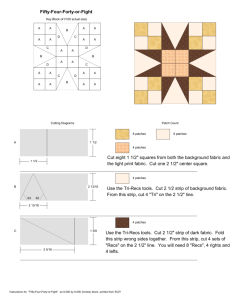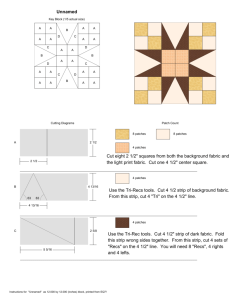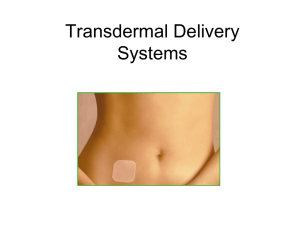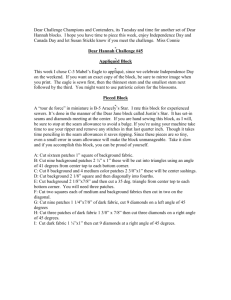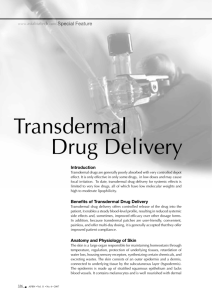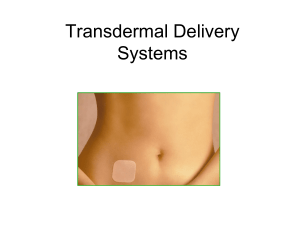Document 13309772
advertisement
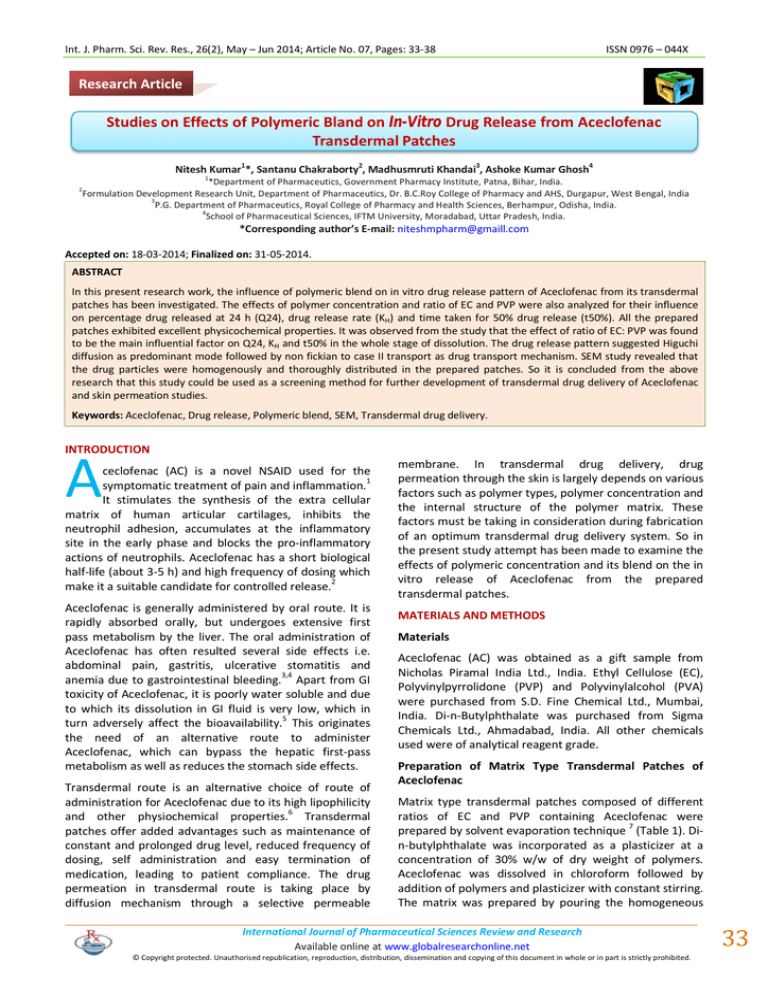
Int. J. Pharm. Sci. Rev. Res., 26(2), May – Jun 2014; Article No. 07, Pages: 33-38 ISSN 0976 – 044X Research Article Studies on Effects of Polymeric Bland on In-Vitro Drug Release from Aceclofenac Transdermal Patches 1 2 3 4 Nitesh Kumar *, Santanu Chakraborty , Madhusmruti Khandai , Ashoke Kumar Ghosh 1 2 *Department of Pharmaceutics, Government Pharmacy Institute, Patna, Bihar, India. Formulation Development Research Unit, Department of Pharmaceutics, Dr. B.C.Roy College of Pharmacy and AHS, Durgapur, West Bengal, India 3 P.G. Department of Pharmaceutics, Royal College of Pharmacy and Health Sciences, Berhampur, Odisha, India. 4 School of Pharmaceutical Sciences, IFTM University, Moradabad, Uttar Pradesh, India. *Corresponding author’s E-mail: niteshmpharm@gmaill.com Accepted on: 18-03-2014; Finalized on: 31-05-2014. ABSTRACT In this present research work, the influence of polymeric blend on in vitro drug release pattern of Aceclofenac from its transdermal patches has been investigated. The effects of polymer concentration and ratio of EC and PVP were also analyzed for their influence on percentage drug released at 24 h (Q24), drug release rate (KH) and time taken for 50% drug release (t50%). All the prepared patches exhibited excellent physicochemical properties. It was observed from the study that the effect of ratio of EC: PVP was found to be the main influential factor on Q24, KH and t50% in the whole stage of dissolution. The drug release pattern suggested Higuchi diffusion as predominant mode followed by non fickian to case II transport as drug transport mechanism. SEM study revealed that the drug particles were homogenously and thoroughly distributed in the prepared patches. So it is concluded from the above research that this study could be used as a screening method for further development of transdermal drug delivery of Aceclofenac and skin permeation studies. Keywords: Aceclofenac, Drug release, Polymeric blend, SEM, Transdermal drug delivery. INTRODUCTION A ceclofenac (AC) is a novel NSAID used for the symptomatic treatment of pain and inflammation.1 It stimulates the synthesis of the extra cellular matrix of human articular cartilages, inhibits the neutrophil adhesion, accumulates at the inflammatory site in the early phase and blocks the pro-inflammatory actions of neutrophils. Aceclofenac has a short biological half-life (about 3-5 h) and high frequency of dosing which make it a suitable candidate for controlled release.2 Aceclofenac is generally administered by oral route. It is rapidly absorbed orally, but undergoes extensive first pass metabolism by the liver. The oral administration of Aceclofenac has often resulted several side effects i.e. abdominal pain, gastritis, ulcerative stomatitis and 3,4 anemia due to gastrointestinal bleeding. Apart from GI toxicity of Aceclofenac, it is poorly water soluble and due to which its dissolution in GI fluid is very low, which in turn adversely affect the bioavailability.5 This originates the need of an alternative route to administer Aceclofenac, which can bypass the hepatic first-pass metabolism as well as reduces the stomach side effects. Transdermal route is an alternative choice of route of administration for Aceclofenac due to its high lipophilicity 6 and other physiochemical properties. Transdermal patches offer added advantages such as maintenance of constant and prolonged drug level, reduced frequency of dosing, self administration and easy termination of medication, leading to patient compliance. The drug permeation in transdermal route is taking place by diffusion mechanism through a selective permeable membrane. In transdermal drug delivery, drug permeation through the skin is largely depends on various factors such as polymer types, polymer concentration and the internal structure of the polymer matrix. These factors must be taking in consideration during fabrication of an optimum transdermal drug delivery system. So in the present study attempt has been made to examine the effects of polymeric concentration and its blend on the in vitro release of Aceclofenac from the prepared transdermal patches. MATERIALS AND METHODS Materials Aceclofenac (AC) was obtained as a gift sample from Nicholas Piramal India Ltd., India. Ethyl Cellulose (EC), Polyvinylpyrrolidone (PVP) and Polyvinylalcohol (PVA) were purchased from S.D. Fine Chemical Ltd., Mumbai, India. Di-n-Butylphthalate was purchased from Sigma Chemicals Ltd., Ahmadabad, India. All other chemicals used were of analytical reagent grade. Preparation of Matrix Type Transdermal Patches of Aceclofenac Matrix type transdermal patches composed of different ratios of EC and PVP containing Aceclofenac were 7 prepared by solvent evaporation technique (Table 1). Din-butylphthalate was incorporated as a plasticizer at a concentration of 30% w/w of dry weight of polymers. Aceclofenac was dissolved in chloroform followed by addition of polymers and plasticizer with constant stirring. The matrix was prepared by pouring the homogeneous International Journal of Pharmaceutical Sciences Review and Research Available online at www.globalresearchonline.net © Copyright protected. Unauthorised republication, reproduction, distribution, dissemination and copying of this document in whole or in part is strictly prohibited. 33 Int. J. Pharm. Sci. Rev. Res., 26(2), May – Jun 2014; Article No. 07, Pages: 33-38 dispersed solution on 4% PVA backing membrane in a flat bottomed petridish, covered with perforated aluminum foil, and dried at 40 °C for 12 h. The dry patches were removed from the petridish and kept in desiccators until use. Table 1: Formulation of matrix type transdermal patches of Aceclofenac Ingredients F1 F2 F3 F4 F5 Aceclofenac (mg) 500 500 500 500 500 EC (mg) 400 300 250 200 100 PVP k30 (mg) 100 200 250 300 400 DBP (ml) 0.5 0.5 0.5 0.5 0.5 PVP: Polyvinyl Pyrrolidone; EC: Ethyl cellulose; DBP: Dibutyl Phthalate. Physicochemical Evaluation of the Prepared Patches Percentage Moisture Uptake Accurately weighed patches were kept in desiccators containing 100 ml of super saturated solution of potassium chloride to maintain 84 % relative humidity until a constant weight was obtained for the patches. The percentage moisture uptake at 30°C and 64 % RH (laboratory ambient condition) was also calculated. The percentage moisture uptake was calculated using the formula below. Percentage moisture absorption = (Final weight − Initial weight) X 100 Initial weight Percentage Moisture Content The patches were accurately weighed and kept in a desiccators containing fused anhydrous calcium chloride at room temperature until it showed a constant weight. The percentage moisture content was calculated using the following formula. Percentage moisture absorption = (Initial weight − Final weight) X 100 Final weight Drug Content ISSN 0976 – 044X flatness was measured. Flatness was calculated by measuring constriction of strips and a 0 % constriction was considered to be 100 % flatness.8 % Constriction = (L − L ) X 100 L Where, L1 = Initial length of each stripe; L2 = Final length of each stripe. Folding Endurance Folding endurance of the prepared patches was determined by repeatedly folding the patches at the same place until it broke. The number of times the patches could be folded at the same place without breaking or cracking gives the folding endurance value. In-Vitro Drug Release Studies In-vitro dissolution studies of the transdermal patches are very important, because by these formulations it is very much essential to maintain the drug concentration on the surface of stratum corneum consistently and substantially greater than the drug concentration in the body, to achieve a constant rate of drug permeation.9,10 In vitro drug release studies from the prepared Aceclofenac loaded transdermal patches were carried out using Basket Type dissolution rate test apparatus (DISSO 2000, LABINDIA, India) in 900 ml of phosphate buffer (pH 6.8) at 32 ± 0.5 °C and 50 rpm for 24 hours.7 The patches were placed in the dissolution vessel in such a manner that the drug matrix should exposed to dissolution media. At each predetermined time intervals, samples were withdrawn from the dissolution vessel, filtered through Whatman filter paper and analyzed for drug content using UVVisible spectrophotometer (UV-2450 Shimadzu, Japan) at 273 nm. The release studies were conducted in triplicate and the percentage of Aceclofenac released at various time intervals was calculated. Analysis of Release Profiles To investigate the mechanism of drug-release and to compare the performance of various matrix formulations, the percentage drug-release versus time profile were used. The goodness of fit was performed using kinetics models such as zero-order, first order, Higuchi and Peppas model. Drug content of the prepared patches were determined by dissolving each patch in phosphate buffer (pH 6.8). The solution was then filtered through Whatman filter paper (0.45 µm). Then, the polymeric debris was washed twice with fresh solvent (phosphate buffer) to extract any adhering drug. The drug content of the filtrate was determined spectrophotometrically at 273 nm (UV-2450, Shimadzu, Japan). Each determination was made in triplicate and average values were reported. Higuchi’s square root model 11 primarily describes drug release from a heterogeneous matrix by diffusion through the intergranular openings created by the porosity of the matrix. This model can be used to describe the drug dissolution from different types of modified release pharmaceutical dosage forms including some transdermal 12 systems. Flatness Where Q is the percentage of drug released in time t, kH is the Higuchi release rate. Longitudinal strips were cut out from the prepared patches. The length of each strip was measured. The variation in the length due to the non-uniformity in Q=k t / Peppas equation, 13, 14 International Journal of Pharmaceutical Sciences Review and Research Available online at www.globalresearchonline.net © Copyright protected. Unauthorised republication, reproduction, distribution, dissemination and copying of this document in whole or in part is strictly prohibited. 34 Int. J. Pharm. Sci. Rev. Res., 26(2), May – Jun 2014; Article No. 07, Pages: 33-38 M ⁄M = kt ISSN 0976 – 044X Scanning Electron Microscopy (SEM) Where n = release exponent indicative of the mechanism of drug release, Mt/M∞ is the fractional release of the drug, t is the release time, K is the kinetic rate constant. Thus Mt / M∞ is the frac on of drug release at me t, a measure of the primary mechanism of the drug release and n characterizes the mechanism of drug release from the formulations during dissolution process. Fourier Transform Infrared (FTIR) Study Fourier Transform Infrared Analysis (FTIR) of pure drug (Aceclofenac) and drug loaded transdermal patches (F) were obtained using FTIR analyzer (Prestige-21, Shimadzu FT-IR, Japan). The pellets were prepared using IR grade KBr in the ratio of 100:1 on KBr-press (Kimaya Engineers, India) under hydraulic pressure of 5 Ton. The samples were scanned over the wave number range of 4000 to 400 cm−1 at the ambient temperature. Differential Scanning Calorimetric Analysis (DSC) Differential Scanning Calorimetric (DSC) thermograms of pure drug (Aceclofenac) (PD), Placebo patch (PL) and drug loaded transdermal patch (F) was obtained using a Differential Scanning Calorimeter (Diamond DSC, PYRIS, Perkin Elmer, USA). Indium standard was used to calibrate the DSC temperature and enthalpy scale. The samples were hermetically sealed in perforated aluminum pans and heated at constant rate of 10°C/min over a temperature range of 50°C to 400°C. The system was purged with nitrogen gas at the rate of 100 mL/min to maintain inert atmosphere. This analysis was performed to evaluate the possible modifications in the internal structure of the drug after incorporation in the dosage form. The surface morphology of the patches was recorded with a Scanning Electron Microscope (S-530, HITACHI, Japan). The samples were spread on an aluminium stub and mounted using adhesive tape. Then the stub was coated with conductive gold with sputter coater attached to the instrument. The stub was then placed in the scanning electron microscope chamber at acceleration voltage of 25 kV and chamber pressure of 0.6 mm Hg. The photograph was taken using scanning electron microscope. RESULTS AND DISCUSSION In the present research work, effects of polymeric concentration, its blend on the in vitro drug release pattern of Aceclofenac from its transdermal patches were studied. Physicochemical Evaluation of the Prepared Patches The results of physicochemical studies have been summarized in Table 2. The result of the moisture uptake (%) and moisture content (%) studies revealed that both moisture uptake and content was found to increase with increasing the concentration of the hydrophilic polymer (i.e. PVP). It was also observed that at higher humidity conditions, moisture uptake was increased as compared to ambient conditions. The moisture uptake values of the prepared patches were found to be 4.12 ± 1.49 to 8.09 ± 1.08% at higher humidity conditions (RH 84 %) whereas at ambient conditions (RH 64 %) it was 3.17 ± 0.92 to 5.45 ± 2.18%. The low moisture uptake at laboratory ambient condition protects the patches from microbial contamination and bulkiness. The less moisture content (3.11 ± 0.27 to 5.48 ± 1.36%) in the patches also helps them to remain stable. Table 2: Physicochemical properties of prepared transdermal patches Parameters F1 F2 F3 F4 F5 RH 84 % 4.12 ± 1.49 5.08 ± 1.28 5.95 ± 0.98 6.83 ± 0.80 8.09 ± 1.08 RH 64 % 3.17 ± 0.92 3.64 ± 1.17 4.56 ± 1.26 4.78 ± 1.13 5.45 ± 2.18 Moisture content (%) 3.11 ± 0.27 3.57 ± 0.72 4.64 ± 1.01 4.71 ± 0.69 5.48 ± 1.36 Drug content (%) 99.83 ± 1.97 98.37 ± 2.01 98.14 ± 1.27 99.01 ± 1.76 97.89 ± 2.36 Moisture uptake (%) Flatness (%) 100 100 100 100 100 Folding endurance 44.18 ± 2.01 40.11 ±1.27 38.72 ±0.98 39.81 ±1.02 39.02 ±1.19 Mean ± SD., n=3. Table 3: Effects of polymer concentration on dependent parameters Q24, KH and t50% Formulation Polymer concentration (EC:PVP) Q24 KH t50% F1 4:1 62.15 14.83 15.02 F2 3:2 73.82 17.44 10.63 F3 1:1 82.58 19.11 9.78 F4 2:3 92.07 20.49 8.74 F5 1:4 - 21.60 7.73 International Journal of Pharmaceutical Sciences Review and Research Available online at www.globalresearchonline.net © Copyright protected. Unauthorised republication, reproduction, distribution, dissemination and copying of this document in whole or in part is strictly prohibited. 35 Int. J. Pharm. Sci. Rev. Res., 26(2), May – Jun 2014; Article No. 07, Pages: 33-38 ISSN 0976 – 044X Table 4: Model fitting drug release from Aceclofenac loaded transdermal patches* Model F1 F2 F3 F4 F5 2 0.921 0.923 0.931 0.913 0.866 2 0.841 0.826 0.857 0.844 0.810 0.981 0.982 0.987 0.973 0.988 Korsmeyer (r ) 0.964 0.979 0.972 0.960 0.975 Release exponent (n) 0.91 0.93 0.88 1.03 0.92 Zero Order (r ) First Order (r ) 2 Higuchi (r ) 2 *Analyzed by the regression coefficient method. Drug content study revealed good uniformity of drug content among the various batches and drug content values were found to be 97.89 ± 2.36 to 99.83 ± 1.97%. The drug content of the prepared formulations was 15 within desired range of 90% to 110%. the addition of hydrophilic substance (PVP) to an insoluble film former (EC) tends to enhance the release 18 rates. The increase in drug release may be due to the ability of the hydrophilic polymer to absorb water and thereby promoting the dissolution. Flatness study revealed 100% flatness and none of the formulation had the difference in the strip lengths before and after their cuts. This study also shows no amount of constriction of the prepared patches which could maintain a smooth surface when applied over the skin leading to intimate contact and help better drug permeation. Folding endurance study assured about the flexibility and integrity of the patches. In-Vitro Drug Release Study In-vitro study is one of the most important parameter to be conducted for all controlled release drug delivery systems. The dissolution studies of the transdermal patches are also very important to observe whether the formulations are able to maintain the drug concentration on the surface of stratum corneum consistently and substantially greater than the drug concentration in the body to achieve a constant rate of drug permeation or not. 16 So, in the present study prepared transdermal patches were subjected to in vitro dissolution testing as a screening method for future in-vitro and in-vivo skin permeation studies. The drug release profile from the prepared transdermal patches is shown in Figure 1. The coefficient of determination values is listed in Table 4. In vitro dissolution study revealed that ratio of EC: PVP had significant influence on drug release from the transdermal patches. In case of formulation F5 (EC:PVP, 1:4), faster drug release was observed as compare to other formulations (For F5, 91.20 ± 2.02% drug release at 20 hours). This may be due to the presence of maximum amount of hydrophilic polymer in this formulation which creates more pores and channels for the drug to diffuse out from the patches.17 It was observed from the study that the effect of ratio of EC: PVP level was found to be the main influential factor on the Q24 from the transdermal patches in the whole stage dissolution. It was also found that the Q24 value increased with increase in amount of PVP. It may be due to the fact that Figure 1: In-vitro dissolution profile of prepared transdermal patches of Aceclofenac It was observed from the study that the ratio of EC: PVP (fraction of PVP) had a significant effect on KH and t50% (Table 3). KH was found to increase linearly with increase in concentration of PVP whereas t50% was found to decrease with increase in concentration of PVP (from formulation F1 to F5). It has also been reported that PVP decreases the drug crystallinity of the transdermal patch, which may also responsible for the increased drug release with an increase in the PVP concentration in the patches. 19 The coefficient of determination (r2) was used as an indicator of the best fitting for each of the models considered (Table 4). Kinetic data of all the formulations suggested a higher coefficient of determination (r2 = 0.973-0.988) with the Higuchi model whereas the release exponent value (n) ranged from 0.88 to 1.03. The coefficient of determination of Higuchi model suggested that the mechanism that led to the release of Aceclofenac was non-Fickian diffusion pattern. Fourier Transform Infrared (FTIR) Study The sample of pure drug and drug loaded transdermal patches (F) (F4) were scanned and spectra are depicted in Figure 2. The pure drug of Aceclofenac showed different characteristic peaks at 3318.45, 2936.30, 1920.65, 1771.72, 1716.44, 1589.14, 1577.42, 1508.06, 1344.24, International Journal of Pharmaceutical Sciences Review and Research Available online at www.globalresearchonline.net © Copyright protected. Unauthorised republication, reproduction, distribution, dissemination and copying of this document in whole or in part is strictly prohibited. 36 Int. J. Pharm. Sci. Rev. Res., 26(2), May – Jun 2014; Article No. 07, Pages: 33-38 1256.38, 1149.46, 1055.76, 926.72, 850.88, 747.82, 609.31, and 510.79 cm-1. Among all the peaks, some major peaks are 3318.45 representing the stretching vibration of OH of COOH group, 2936.30 representing C-H stretching vibration of CH2 groups (symmetric), 1716.44 for stretching vibration of C=O attached with methylene group and ether, 1508.06 for C=C ring stretching, 1344.24 for C-H bending vibration of CH2 groups (symmetric), 1256.38 for C-N stretching vibration of secondary aromatic amine, 1149.46 for C-O-C, 850.88 and 747.82 representing substituted phenyl rings. It was observed from the FTIR study that all the major peaks of aceclofenac were almost intact in the prepared transdermal patch. This indicates no interaction between the drug and polymers, in the patch prepared by the solvent evaporation technique. ISSN 0976 – 044X thoroughly distributed in the patch. No drug crystals were observed indicating relative amorphous state of Aceclofenac in the patch which has already confirmed by DSC studies. Figure 3: DSC thermogram of pure Aceclofenac (PD), placebo (PL) and drug loaded transdermal patches (F) (F4) Figure 2: FTIR spectra of pure drug and drug loaded transdermal patches (F4) Differential Scanning Calorimetric Analysis (DSC) The physicochemical state of the drug in the transdermal patches was assessed by DSC analysis. DSC thermograms of pure Aceclofenac (PD), placebo (PL) and drug loaded transdermal patches (F) (F4) are shown in Figure 3. In case of pure drug, a sharp endothermic peak was observed at 156.40 °C, corresponding to the melting point of Aceclofenac. The significantly decreased intensity and sharpness of the endothermic peaks corresponding to the melting point of Aceclofenac in the transdermal patches indicated partial dissolution of Aceclofenac in the prepared polymeric system. Decreased intensity and sharpness of the endothermic peak of Aceclofenac also suggested the change in physical state of Aceclofenac from crystalline to amorphous.20 So, DSC study revealed that crystalline Aceclofenac when incorporated in transdermal dosage form it changed its state and present in a relatively amorphous or molecularly dispersed state. Scanning Electron Microscopy (SEM) The surface morphology of the prepared patches (F4) was studied using SEM (Figure 4). It was observed that due to fairly good solubility of Aceclofenac in the polymeric system, the drug particles were homogenously and Figure 4: Scanning electron photomicrographs of prepared patches (F4) (A=200 X and B=1000 X) CONCLUSION It is concluded from the study that polymer concentration and ratio of EC and PVP greatly influence the percentage drug released at 24 h, drug release rate and time taken for 50% drug release. The drug release pattern suggested Higuchi diffusion as predominant mode followed by non fickian to case II transport as drug transport mechanism. So it is concluded from the above research that this study could be used as a screening method for further development of transdermal drug delivery of Aceclofenac and skin permeation studies. Further, in vitro and in vivo skin permeation studies have to be carried out get optimized transdermal delivery system for controlled release of Aceclofenac. REFERENCES th 1. Maryadele JO, Smith A, The Merck Index, 12 ed, Merck Research Laboratories, NJ, 1996. 2. Khandai M, Chakraborty S, Ghosh AK, Critical analysis of algino-carbopol multi particulate system for the improvement of flow ability, compressibility and tabletting properties of a poor flow drug, Powder Technology, 253, 2014, 223-229. International Journal of Pharmaceutical Sciences Review and Research Available online at www.globalresearchonline.net © Copyright protected. Unauthorised republication, reproduction, distribution, dissemination and copying of this document in whole or in part is strictly prohibited. 37 Int. J. Pharm. Sci. Rev. Res., 26(2), May – Jun 2014; Article No. 07, Pages: 33-38 3. 4. 5. Chakraborty S, Khandai M, Ghosh AK, Design, characterization and pre-clinical evaluation of Aceclofenac loaded algino-gelatin microspheres for targeted drug delivery, Drug Delivery Letters, 3, 2013, 79-90. Lee J, Lee Y, Kim J, Yoon M, Choi YW, Formulation of microemulsion systems for transdermal delivery of Aceclofenac, Archives of Pharmacal Research, 28, 2005, 1097-1102. Guasch J, Montero JL, Felipe A, Carrasco E, Juliá S, Pharmacology of the potent new non-steroidal antiinflammatory agent Aceclofenac, Arzneimittelforschung, 41, 1991, 1265-1276. ISSN 0976 – 044X systems, Revista Portuguesa de Farmacia & thinsp, 46, 1996, 4-8. 13. Korsmeyer RW, Gurny R, Docler E, Buri P, Peppas NA, Mechanism of solute release from porous hydrophilic polymers, International Journal of Pharmaceutics, 15, 1983, 25-35. 14. Ritger PL, Peppas NA, A simple equation for description of solute release II. Fickian and anomalous release from swellable devices, Journal of Control Release, 5, 1987, 3742. 6. Faiyaz S, Sanjula B, Alka A, Javed A, Mohammed A, Sheik S, Nano emulsions as vehicles for transdermal delivery of Aceclofenac, AAPS Pharm Sci Tech, 8, 2007, 191-199. 15. Yong CS, Choi JS, Quan QZ, Rhee JD, Kim CK, Lim SJ, Kim KM, Choi HG, Effect of sodium chloride on the gelation temperature, gel strength and bioadhesive force of poloxamer gels containing Diclofenac sodium, International Journal of Pharmaceutics, 226, 2001, 195-205. 7. Pattnaik S, Swain K, Mallick S, Influence of polymeric system and loading dose on drug release from alfuzosin hydrochloride transdermal films, Latin American Journal of Pharmacy, 28, 2009, 62-69. 16. Fusun A, Ahmet E, Investigation of the effect of different adjuvant on felodipine release kinetics from sustained release monolithic films, International Journal of Pharmaceutics, 131, 1996, 183-189. 8. Arora P, Mukherjee B, Design, development, physicochemical, and in vitro and in vivo evaluation of transdermal patches containing Diclofenac diethyl ammonium salt, Journal of Pharmaceutical Sciences, 91, 2002, 2076-2089. 17. Bodmeier R, Paeratakul O, Evaluation of drug-containing polymer films prepared from aqueous latexes, Pharmaceutical Research, 6, 1989, 725-730. Sood A, Panchagnula R, Role of dissolution studies in controlled release drug delivery system, STP Pharma Sciences, 9, 1999, 157-168. 18. Arora P, Mukherjee B, Design, development, physicochemical, and in vitro and in vivo evaluation of transdermal patches containing Diclofenac diethyl ammonium salt, Journal of Pharmaceutical Sciences, 91, 2002, 2076-2089. 10. De PK, Mallick S, Mukherjee B, Sengupta S, Pattnaik S, Chakraborty S, Optimization of in-vitro permeation pattern of ketorolac tromethamine transdermal patches, Iranian Journal of Pharmaceutical Research, 10, 2011, 193-201. 19. Guyot M, Fawaz F, Design and in vitro evaluation of adhesive matrix for transdermal delivery of propranolol, International Journal of Pharmaceutics, 204, 2000, 171182. 11. Higuchi T, Mechanism of sustained-action medication, Theoretical analysis of rate of release of solid drugs dispersed in solid matrices, Journal of Pharmaceutical Sciences, 52, 1963, 1145-1149. 20. Samal HB, Debata J, Kumar NN, Sneha S, Patra PK, Solubility and dissolution improvement of aceclofenac using βcyclodextrin, International Journal of Drug Development and Research, 4, 2012, 326-333. 9. 12. Costa P, Ferreira DC, Sousa Lobo JM, Determination of drug release profiles of nitroglycerin transdermal therapeutic Source of Support: Nil, Conflict of Interest: None. International Journal of Pharmaceutical Sciences Review and Research Available online at www.globalresearchonline.net © Copyright protected. Unauthorised republication, reproduction, distribution, dissemination and copying of this document in whole or in part is strictly prohibited. 38
